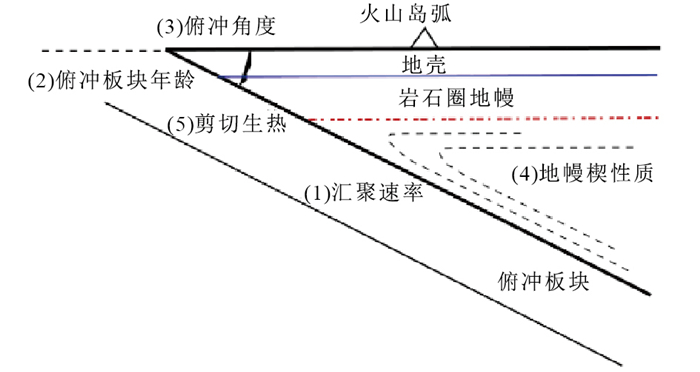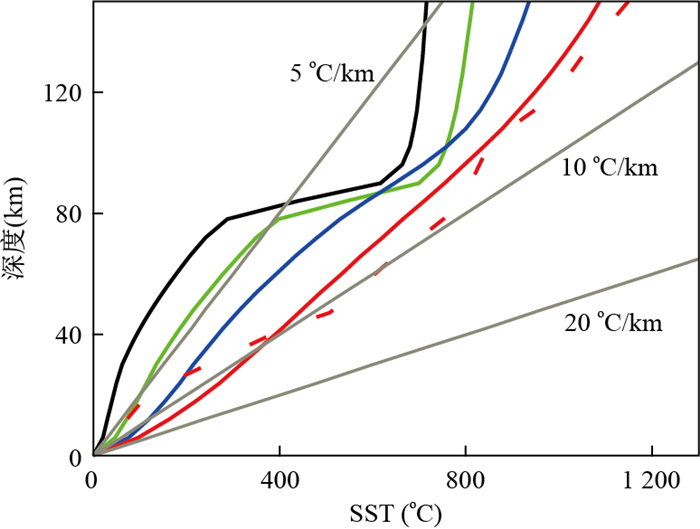Numerical Modeling of Thermal Structure for the Continental Subduction Zones
-
摘要: 俯冲带热结构是控制俯冲板块演化的最主要因素之一.前人通过建立解析模型和数值模型对大洋俯冲带热结构进行了一系列研究,发现俯冲板块年龄和俯冲速度是影响俯冲带热结构的关键因素.为了认识大陆俯冲带热结构,特别是理解数值模型结果与岩石学结果之间的差异,我们建立了二维大陆俯冲带运动学和动力学数值模型研究其热结构演化.模型结果显示,如果大陆俯冲板块的俯冲速度与角度和大洋板块一致的话,较低的大陆俯冲带初始温度导致其板块温度比大洋俯冲带低.但是,当大陆俯冲板块的初始温度较高,俯冲速度超慢并且考虑大陆地壳中的放射性元素生热时,模型得到的大陆俯冲带热结构能够解释通过高压和超高压变质岩得到的较热的俯冲板块温度.另一方面,如果俯冲板块与上覆板块存在动力学解耦作用,也能够得到较热的俯冲温压数据.Abstract: The thermal structure of subduction zone is one of the most important factors controlling the evolution of subduction plate. Previous studies on the thermal structure of oceanic subduction zones have been carried out by establishing analytical and numerical models. It is found that the age and velocity of the subduction plate are the key factors affecting the thermal structure of the subduction zones. In order to further understand the thermal structure of the continental subduction zone,especially to understand the difference between the numerical model results and petrological results,we established two-dimensional numerical kinematic and geodynamic models of the continental subduction zone to study its thermal structure evolution. The model results show that if the subduction velocity and dip angle of the continental plate are the same as those of the oceanic plate,lower initial temperature causes the continental subduction zone to be colder than the oceanic subduction zone. However,when the initial temperature of the continental plate is high,the subduction velocity is super slow and the heat generation of radioactive elements in the continental crust is taken into account,the thermal structure of the continental subduction zone obtained by the model can explain the hot subduction temperature obtained from high-pressure and ultra-high-pressure metamorphic rocks. On the other hand,if there is dynamic decoupling between the subduction plate and the overlying plate,the hot subduction temperature can also be obtained.
-
Key words:
- subduction zone /
- thermal structure /
- continental subduction zone /
- numerical modeling /
- geodynamics
-
图 1 俯冲带热结构的主要控制因素
包括汇聚速率、俯冲板块年龄、俯冲角度、地幔楔性质和剪切生热等;据Zheng(2019)
Fig. 1. Key controlling parameters for thermal structure of subduction zones
图 2 不同模型参数下的大陆俯冲板块的表面温度(SST)随深度的分布
黑色线条代表俯冲速度为5 cm/a,地表热流为30 mW/m2的大陆俯冲板块得到的热结构;绿色线条代表将地表热流从30 mW/m2增加到65 mW/m2得到的热结构;蓝色线条代表不仅增加地表热流,同时将俯冲速度从5 cm/a降低到1 cm/a得到的热结构;红色线条代表进一步的降低俯冲速度到0.5 cm/a,同时考虑大陆地壳的放射性元素生热效应得到的热结构.以上模型中俯冲角度均为30°.红色虚线代表使用动力学模型得到的热结构.其中的三条灰色线条分别代表 5 ℃/km、10 ℃/km和20 ℃/km的地温梯度线
Fig. 2. Slab surface temperature (SST) for the continental subduction zones with different model parameters
-
Billen, M.I., Hirth, G., 2007.Rheologic Controls on Slab Dynamics.Geochemistry, Geophysics, Geosystems, 8(8):Q08012. https://doi.org/10.1029/2007gc001597 Burov, E., Francois, T., Agard, P., et al., 2014.Rheological and Geodynamic Controls on the Mechanisms of Subduction and HP/UHP Exhumation of Crustal Rocks during Continental Collision:Insights from Numerical Models.Tectonophysics, 631:212-250. https://doi.org/10.1016/j.tecto.2014.04.033 England, P., Wilkins, C., 2004.A Simple Analytical Approximation to the Temperature Structure in Subduction Zones.Geophysical Journal International, 159(3):1138-1154. doi: 10.1111/j.1365-246X.2004.02419.x Kohn, M.J., Castro, A.E., Kerswell, B.C., et al., 2018.Shear Heating Reconciles Thermal Models with the Metamorphic Rock Record of Subduction.Proceedings of the National Academy of Sciences, 115(46):11706-11711. doi: 10.1073/pnas.1809962115 Leng, W., Huang, L.Z., 2018.Progress in Numerical Modeling of Subducting Plate Dynamics.Science China:Earth Sciences, 61(12):1761-1774. doi: 10.1007/s11430-017-9275-4 Leng, W., Mao, W., 2015.Geodynamic Modeling of Thermal Structure of Subduction Zones.Science China:Earth Sciences, 58(7):1070-1083. doi: 10.1007/s11430-015-5107-5 McKenzie, D.P., 1969.Speculations on the Consequences and Causes of Plate Motions.Geophysical Journal International, 18(1):1-32. https://doi.org/10.1111/j.1365-246x.1969.tb00259.x Molnar, P., England, P., 1990.Temperatures, Heat Flux, and Frictional Stress near Major Thrust Faults.Journal of Geophysical Research, 95(B4):4833-4856. doi: 10.1029/JB095iB04p04833 Moresi, L.N., Solomatov, V.S., 1995.Numerical Investigation of 2D Convection with Extremely Large Viscosity Variations.Physics of Fluids, 7(9):2154-2162. doi: 10.1063/1.868465 Peacock, S.M., 2003.Thermal Structure and Metamorphic Evolution of Subducting Slabs.Inside the Subduction Factory. AGU, Washington D. C., 7-22. Peacock, S.M., Wang, K., 1999.Seismic Consequences of Warm versus Cool Subduction Metamorphism:Examples from Southwest and Northeast Japan.Science, 286(5441):937-939. doi: 10.1126/science.286.5441.937 Penniston-Dorland, S.C., Kohn, M.J., Manning, C.E., 2015.The Global Range of Subduction Zone Thermal Structures from Exhumed Blueschists and Eclogites:Rocks are Hotter than Models.Earth and Planetary Science Letters, 428:243-254. https://doi.org/10.1016/j.epsl.2015.07.031 Rüpke, L.H., Morgan, J.P., Hort, M., et al., 2004.Serpentine and the Subduction Zone Water Cycle.Earth and Planetary Science Letters, 223:17-34. doi: 10.1016/j.epsl.2004.04.018 Stern, R.J., 2002.Subduction Zones.Reviews of Geophysics, 40(4):2001RG000108. http://d.old.wanfangdata.com.cn/NSTLQK/NSTL_QKJJ0232216228/ Syracuse, E.M., van Keken, P.E., Abers, G.A., 2010.The Global Range of Subduction Zone Thermal Models.Physics of the Earth and Planetary Interiors, 183(1-2):73-90. doi: 10.1016/j.pepi.2010.02.004 Turcotte, D.L., Schubert, G., 2002.Geodynamics.Cambridge University Press, New York, 456. van Keken, P.E., Currie, C., King, S.D., et al., 2008.A Community Benchmark for Subduction Zone Modeling.Physics of the Earth and Planetary Interiors, 171(1-4):187-197. https://doi.org/10.1016/j.pepi.2008.04.015 van Keken, P.E., Hacker, B.R., Syracuse, E.M., et al., 2011.Subduction Factory:4.Depth-Dependent Flux of H2O from Subducting Slabs Worldwide.Journal of Geophysical Research, 116(B1):B01401. https://doi.org/10.1029/2010jb007922 van Keken, P.E., Kiefer, B., Peacock, S.M., 2002.High-Resolution Models of Subduction Zones:Implications for Mineral Dehydration Reactions and the Transport of Water into the Deep Mantle.Geochemistry, Geophysics, Geosystems, 3(10):2001GC000256. https://doi.org/10.1029/2001gc000256 van Keken, P.E., Wada, I., Sime, N., et al., 2019.Thermal Structure of the Forearc in Subduction Zones:A Comparison of Methodologies.Geochemistry, Geophysics, Geosystems, 20(7):3268-3288. https://doi.org/10.1029/2019gc008334 Zheng, Y.F., 2012.Metamorphic Chemical Geodynamics in Continental Subduction Zones.Chemical Geology, 328:5-48. https://doi.org/10.1016/j.chemgeo.2012.02.005 Zheng, Y.F., 2019.Subduction Zone Geochemistry.Geoscience Frontiers, 10(4):1223-1254 doi: 10.1016/j.gsf.2019.02.003 Zheng, Y.F., Chen, Y.X., 2016.Continental versus Oceanic Subduction Zones.National Science Review, 3(4):495-519. https://doi.org/10.1093/nsr/nww049 -










 下载:
下载:


